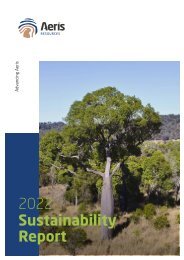Aeris Annual Report 2022
Create successful ePaper yourself
Turn your PDF publications into a flip-book with our unique Google optimized e-Paper software.
INJURY RATES<br />
The total recordable injury frequency rate (TRIFR) for<br />
<strong>Aeris</strong> for FY<strong>2022</strong> was 13.7, which was similar to the FY2021<br />
frequency rate of 13.3 (based on 1 million working hours,<br />
or equivalent/500ppl/year).<br />
Recordable injuries are defined as any injury<br />
that requires medical treatment and results in<br />
a restricted work plan, meaning the individual<br />
is unable to perform their usual role.<br />
Total lost time injury (LTI) rates rose from 2.9 in FY2021 to<br />
3.6 in FY<strong>2022</strong>. The LTI’s onsite were low in severity, but long<br />
in duration of recovery time. The frequency rate increased<br />
due to an increase in LTI’s, coupled with a decrease in<br />
work hours across the business.<br />
LTI frequency rate is an important part of measuring our<br />
safety performance onsite, but more than that, it serves<br />
as a marker and talking point for the workforce and other<br />
key stakeholders to come together and discuss how safety<br />
can be improved prior to and as a discussion point once<br />
incidents have occurred.<br />
In the last six months of the year, rates have been<br />
positively trending showing significant improvement across<br />
the portfolio. Both operations experienced a change in site<br />
leadership in FY<strong>2022</strong> and as the workforce stabilises and<br />
ongoing safety improvements are implemented,<br />
we anticipate increased safety performance.<br />
HYGIENE EXPOSURE LIMITS<br />
Hygiene exposure is monitored at both sites in relation<br />
to diesel particulate and respirable silica levels to<br />
ensure the health of our workforce is maintained.<br />
The identification of health hazards at our operations<br />
is undertaken by independent and certified Occupational<br />
Hygienists in accordance with the requirements of industry<br />
Recognised Standards.<br />
In FY<strong>2022</strong>, all diesel particulate monitoring results were<br />
below the required levels for acceptable occupational<br />
exposure limits.<br />
Respirable silica is an ongoing risk in an underground<br />
environment and in FY<strong>2022</strong>, we experienced seven<br />
exceedances at our Tritton Copper Operations,<br />
and only one exceedance reported at our<br />
Cracow Gold Operations.<br />
All exceedances were thoroughly investigated, with<br />
appropriate remedial actions identified and implemented.<br />
These included: the implementation of real-time dust<br />
monitoring devices, the ongoing services of Occupational<br />
Hygienists to assist in providing training and feedback<br />
to personnel that participate in sampling programs and<br />
the continued enforcement of appropriate respiratory<br />
protective devices as per site policies and procedures.<br />
HEALTH AND HYGIENE MANAGEMENT PLANS<br />
<strong>Annual</strong> reviews of the site’s Health and Hygiene<br />
Management Plans (HHMP) are undertaken by certified<br />
Occupational Hygienists. The purpose of this review<br />
is to highlight improvements to the site’s exposure<br />
profiles, including whether controls implemented<br />
over the previous year have been successful.<br />
To demonstrate ongoing management and compliance, a<br />
quarterly review of hygiene monitoring is to be completed<br />
at each site and is to be submitted to the Group Manager<br />
– Health, Safety and Risk, highlighting reporting results, key<br />
findings and actions undertaken in the previous quarter.<br />
ADVANCING AERIS<br />
37





